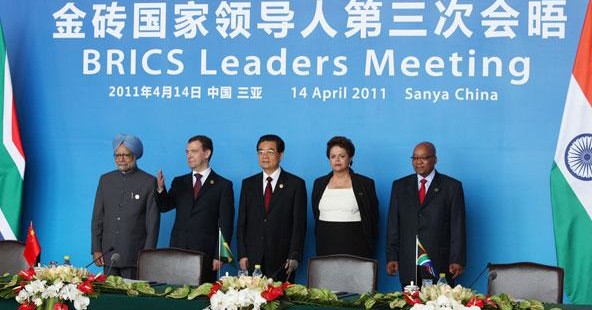
Developing Countries Plan to Challenge U.S. Dollar
New eras do not announce themselves with billboards or welcoming brochures. They arrive by way of many disparate events. Last week we witnessed one: the gathering in southern China of leaders from the world’s most dynamic emerging economies –the nations we now call the BRICS (Brazil, Russia, India, China, and South Africa). The summit in Hainan most persuasively is a determination to use the BRICS’ global clout to take some of the intellectual initiative away from the advanced industrial nations.
There is a long history behind such ambitions, beginning with the Non–Aligned Movement in the mid–1950s. More recently, after the Asian financial crisis in the late–1990s, the region was alive with ideas intended to make room for an alternative to the neoliberal economic strategy the West was urging: an Asian monetary fund, a regional central bank, bilateral currency swaps, an “Asian Davos.”
Some of these concepts have taken root, notably swap agreements intended to protect local currencies from a sudden rush (or departure) of speculators. There are now half a dozen of these pacts in effect around East Asia.
As a circle of power such as the European Union, the BRICS bloc is a work in progress, to be sure. But their summit was a loud, clanging bell telling the rest of the planet that their increasing sway in global affairs is not to be underestimated.
BRICS wants a more diversified international reserve
system, less centered on the dollar.
A decade ago, there was not even a thought of the BRICS as a group of nations with shared interests. But the past 10 years of historically unprecedented economic expansion has changed the BRICS status, as their leaders plainly recognize. Together they now represent 40 percent of the world’s people, 18 percent of world trade, and not quite half of global economic growth. The BRICS remain a varied lot, but if the summit is any guide, their intent is to challenge the U.S. and other advanced industrial nations as leading the global economy.
The direction of the one-day summit could hardly be clearer. BRICS expects a more prominent role in multilateral institutions such as the IMF and the World Bank, a stronger presence in the U.N. Security Council, coordinated regulation of the financial markets, and—note this well—a more diversified international reserve system less centered on the dollar. Any successful effort to develop an internationally accepted basket of reserve currencies—starting with the IMF’s Special Drawing Rights—would have to make officials at the U.S. Treasury nervous about long-term overseas support for American debt. It would, in effect, deprive the Fed of the zero interest rate policy—ZERP in the trade—that is now in place.
Altogether, the catch-all phrase in the declaration is “greater democracy in international relations.” The BRICS intend this to apply to everything from financial issues to terrorism, security, climate change, and globally coordinated energy policies.
“The thought is to espouse an alternative to the reigning orthodoxy on globalization, and this is significant,” says Ha-Joon Chang, an economics professor at Cambridge University. “The question is whether they can continue coherently as a group and communicate a credible alternative effectively.”
It is a good question. India and China fought a war not so many years ago. India, Brazil, and South Africa are democracies, while China and Russia are not. India and China are manufacturing economies, while the other three depend on resource exports. Not least, China runs considerable trade surpluses with India and Brazil, neither of which is especially pleased with Beijing’s import barriers. But the differences make the common ground more interesting.
There are three points that distinguish the Hainan gathering from all past efforts to coalesce a bloc of developing nations.
- One is the persistence of a non–Western vision amid an extended phase of economic expansion. There is no crisis to overcome this time, as in the mid–1990s, and none of the weak “third worldism” that inspired the Non–Aligned Movement half a century ago.
- Equally, the BRICS are playing to their own strengths. The intent, if you read theHainan declaration, is plainly to capitalize on their growing economic influence by developing home-grown policy initiatives rather than simply defend themselves against the West’s traditional concepts of markets and societies.
- Finally, these nations cover four continents and appear to have advanced from the regional approach evident a decade ago: let’s have a Latin American common market and an Asian monetary agency.
Manmohan Singh, India’s prime minister, was among the five heads of state to convene in China last week. “The best is yet to come,” he said after the session was concluded. It would be wise to take the BRICS at their word.

